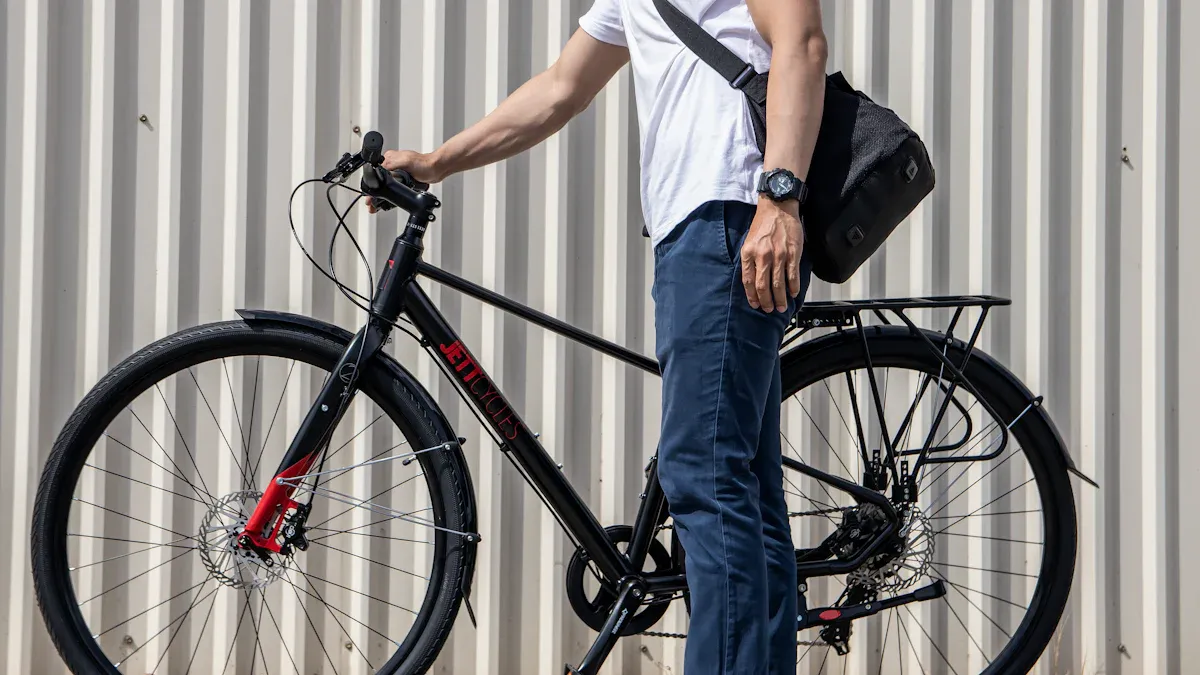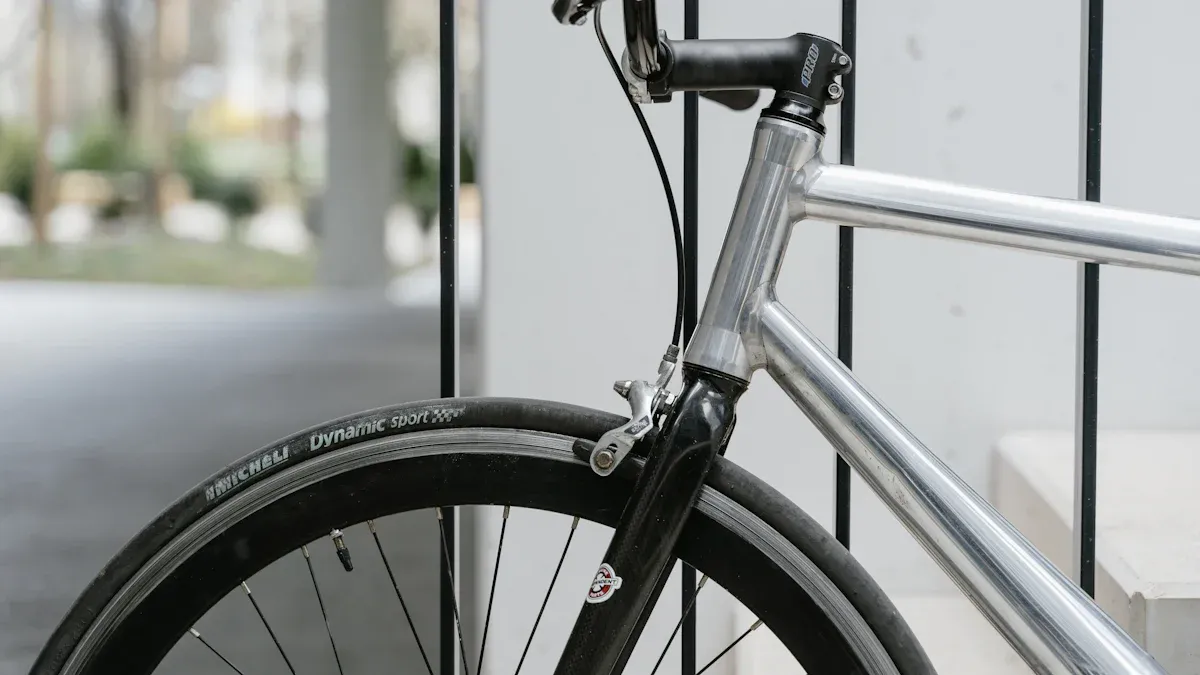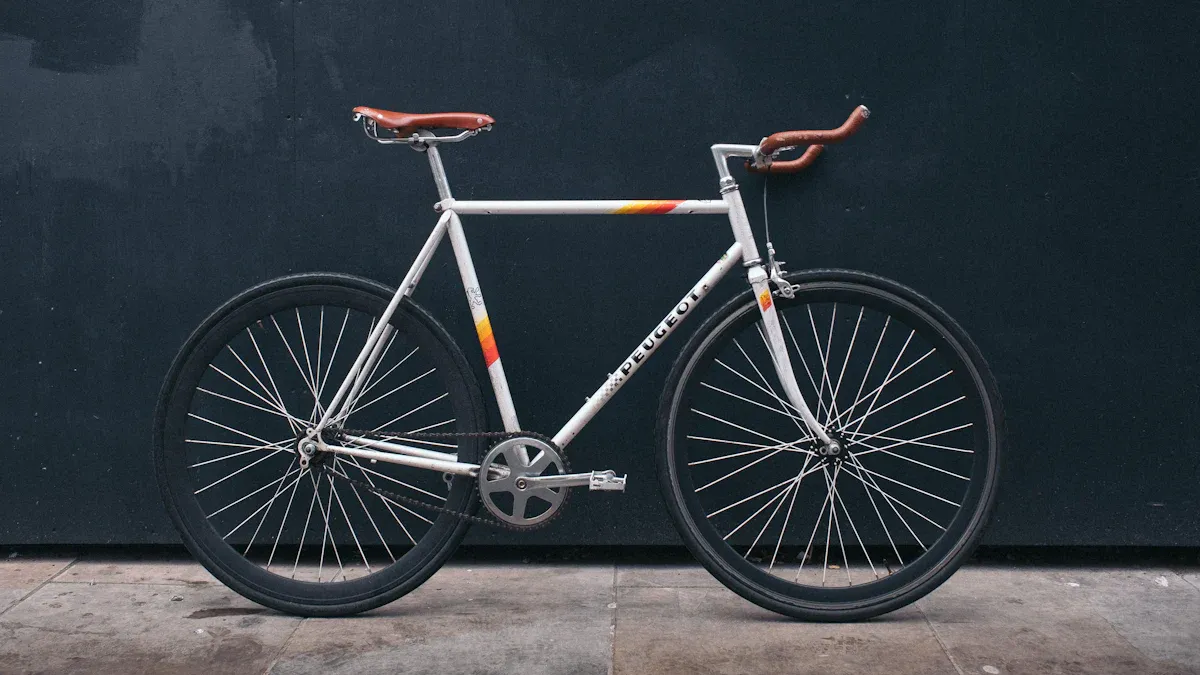
Choosing the best bike frame material is crucial for your ride. The right material impacts how well the bike performs and its durability. For instance, steel frames are strong and easy to repair. Aluminum frames are lightweight and resist rust. Carbon fiber frames, while often more expensive, are highly durable and can last over five years with proper care. Lastly, titanium frames offer a combination of lightness and strength. Understanding the best bike frame material options helps you select the one that suits your needs perfectly.
Key Takeaways
Steel frames are strong and last a long time. They are comfortable and easy to fix. However, they are heavier and need care to prevent rust.
Aluminum frames are light and do not rust. This makes them good for beginners. But they can crack and are hard to repair.
Carbon fiber frames are very strong and light. They can last over ten years if you take care of them. However, repairs can be expensive and cracks might be hard to see.
Titanium frames are light and strong. They are very durable and comfortable, but they cost more money.
Pick your bike frame material based on how you ride, your budget, and how much maintenance you want to do for the best experience.
Steel Frames

Durability and Strength
Steel bike frames are known for being very strong and lasting a long time. Steel frames made from chromoly (a special kind of steel) are both tough and flexible. This helps them absorb shocks and hits better than many other materials. Steel frames can bend many times without breaking. This is great for riders who ride on rough paths or in cities.
To help you understand better, here’s a table comparing the strength and limits of different bike frame materials:
Material | Ultimate Tensile Strength (MPa) | Fatigue Limit / Endurance Limit | Notes on Fatigue Behavior |
|---|---|---|---|
Steel alloy 4130 | ~560 | Yes (0.35 to 0.6 × tensile strength) | Can handle endless cycles below fatigue limit; more durable under repeated stress |
Aluminium alloy 6061 | ~310 | No | No fatigue limit; will eventually fail under cyclic loading regardless of load size |
Titanium alloy 3AL-2.5V | ~620 | Yes | Has fatigue limit similar to steel |
As shown, steel is about twice as strong as aluminum, making it a great choice for durability. Steel and titanium can also handle repeated stress without breaking, which is important for long-term use.
Pros and Cons
Steel frames have many benefits that attract many cyclists:
Strength: Steel is very strong and can handle rough use and hits.
Ride Quality: Steel’s flexible nature gives a smooth, springy ride, making long trips more comfortable.
Affordability: Steel frames usually cost less than aluminum or carbon frames.
Repairability: Steel frames are easy to fix. You can weld and change them without much trouble, often at a lower cost than buying a new frame.
But there are some downsides to think about:
Weight: Steel frames are often heavier than aluminum or carbon frames, which may not be good for racers who want to save weight.
Corrosion: Steel can rust, especially in wet or cold weather. You need to take care of it regularly to keep it in good shape.
Experts say that well-made steel frames keep their shape and strength over time. They can handle tough tests, often going beyond industry standards. For example, steel bike frames have shown great long-term durability in lab tests that mimic different riding conditions, including impacts and overloads. These tests show that frames can last over 100,000 cycles without cracking or changing shape.
Aluminum Frames

Durability Factors
Many cyclists like aluminum frames for a few reasons. First, they are light. This makes your bike easier to control and speed up. This is great if you love going fast or climbing hills. Aluminum also resists rust naturally. If it does rust, it creates a protective layer called aluminum oxide. This layer stops more damage and keeps your frame strong. But, you need to keep your frame clean. Dirt, salt, and grime can wear away this protective layer.
To take care of your aluminum frame, follow these tips:
Dry the frame well after cleaning or being wet.
Store your bike in a dry spot away from bad weather.
Use special bike frame protectants or waxes for extra safety.
Here’s a quick look at some important factors that affect how long aluminum frames last:
Factor | Description |
|---|---|
Aluminum Alloy (6061) | A common alloy that gives stiffness, strength, toughness, rust resistance, and good workability. |
Mechanical Properties | Tensile strength (>260 MPa), yield strength (>240 MPa), elongation improves with heating (up to ~25%). |
Extrusion | Determines tube thickness and weight based on frame shape and load needs. |
Pros and Cons
Aluminum frames have their own good and bad points.
Pros:
Lightweight: They weigh about one-third of steel, making them easier to ride.
Stiffness: Aluminum helps transfer power well, giving you a quick ride.
Durability: They can take hits without breaking, making them strong and reliable.
Affordability: Usually, aluminum frames cost less than carbon fiber or titanium, so many riders can buy them.
Cons:
Comfort: They might be less comfy than carbon fiber, but new methods have made this better.
Susceptibility to Damage: Aluminum frames can get dents and cracks, especially at welds, which can be unsafe.
Repairability: Unlike steel, aluminum frames usually can’t be fixed if they get damaged.
Carbon Fiber Frames
Durability Characteristics
Carbon fiber frames are known for being very strong. They are about 3.8 times stronger than aluminum. This means they are light but can handle a lot of pressure. These frames go through tough tests to make sure they are safe and durable. The tests mimic real riding situations. Well-made carbon fiber frames can last over ten years if you take care of them.
Even though carbon fiber is strong, it can have hidden cracks after hard hits. This is why checking and maintaining your frame is important. Unlike aluminum or steel, carbon fiber does not dent or bend. Instead, it can crack, which might not be easy to see. So, it’s important to look for any damage on your frame.
Pros and Cons
Carbon fiber frames have both good and bad points. Here’s a quick list:
Pros:
Lightweight: They can save you about 1-2 pounds compared to aluminum frames, making your bike easier to ride.
Stiffness: The way they are built helps transfer power well, improving your ride.
Aesthetics: Carbon fiber frames usually have a nice smooth finish that looks cool.
Corrosion Resistance: They work well in all weather, so you don’t have to worry about rust.
Cons:
Cost: Carbon fiber frames can be expensive because they are hard to make.
Repair Complexity: If your frame gets damaged, fixing it needs special skills and can cost a lot.
Ride Feel: Some riders think carbon fiber frames feel stiffer, especially without suspension.
Titanium Frames
Durability and Flexibility
Titanium bike frames are known for being lightweight and very strong. They are lighter than steel but just as tough. Here are some important features that make titanium a great choice:
High Strength-to-Weight Ratio: Titanium is lighter than steel but still strong. This makes it perfect for those who want a lightweight bicycle frame that lasts long.
Corrosion Resistance: Titanium does not rust easily. This means your frame can last for many years, even in bad weather.
Flexibility: Titanium is more flexible than steel. This helps absorb shocks and makes your ride smoother.
Fatigue Resistance: Titanium can handle repeated stress without breaking. This is better than aluminum, which wears out faster.
In real life, titanium frames usually last longer than steel and aluminum. For example, they can take over 2.2 million stress cycles, showing how durable they are. This makes them a good choice for long rides or rough paths.
Pros and Cons
Like any material, titanium has good and bad points. Here’s a quick look at the pros and cons:
Pros:
Comfort and Performance: Titanium frames offer a nice mix of comfort and performance. They dampen vibrations, making them great for long rides.
Durability: They can handle hits and tough conditions, so you won’t need to repair them often.
Longevity: With good care, titanium frames can last for many years, often with lifetime warranties.
Cons:
Cost: The main downside is the high price. The materials and special skills needed to weld titanium make it expensive.
Welding Challenges: Working with titanium needs expert welders and special techniques, which can make it hard to find.
Evaluating Bike Frame Materials
Key Factors to Consider
When you pick the best bike frame material, think about some important factors. Here’s what to check:
Factor | Carbon Fiber | Aluminum Alloy |
|---|---|---|
Fatigue Resistance | Very good if not damaged | Has a set fatigue life; gets weaker over time |
Impact Resistance | Can be damaged by impacts; hidden cracks may happen | More tough; usually dents before breaking |
Corrosion | Not much info, but usually resistant | Good at resisting rust |
Repairability | Hard to fix; needs special skills | Usually easier to repair |
Long-term Durability | High if not damaged | Good but limited by fatigue life |
This table shows why fatigue resistance, impact resistance, corrosion resistance, and repairability matter. These factors are key when checking how durable bike frame materials are.
Testing and Reviews
Consumer reviews and tests from experts give helpful info about how different bike frame materials perform over time. For example, steel frames often get high ratings for comfort and durability. They are great at absorbing bumps, making them popular for touring and commuting. Even though they can be heavier, many riders trust them.
Aluminum frames are common for beginner and mid-range bikes because they are light and affordable. However, they can crack more easily, which can lead to costly repairs. On the other hand, carbon fiber frames are known for being light and strong, making them perfect for high-end road and mountain bikes. But, fixing them can be rare and expensive.
Titanium frames are known for lasting a long time and resisting rust. They give a unique ride that feels both stiff and smooth, but they cost more. Overall, the long-term performance of these materials often matches their prices. More expensive materials usually offer better durability and ride quality.
When it comes to warranties, big bike brands often give lifetime warranties on steel and carbon frames, showing their durability. Aluminum frames usually have shorter warranties, around two years. Keep in mind, warranties usually only cover the first owner and don’t include damage from accidents or misuse.
Choosing the best bike frame material is very important for how long it lasts and how well it works. Here’s a quick summary of what to think about:
Steel frames are strong and comfy, great for city riding.
Aluminum frames are light and fast but can break easier.
Carbon fiber frames are high-performing but can be expensive and fragile.
Titanium frames mix lightness and strength, perfect for long rides.
Consider how you ride, your budget, and how much care you want to give. Each material has good and bad points, so choose one that matches your needs. Enjoy your ride! 🚴♂️
FAQ
What is the best bike frame material for beginners?
Aluminum frames are usually the best for beginners. They are light, cheap, and easy to ride. They also last well for casual biking.
How long do carbon fiber frames last?
If you take care of them, carbon fiber frames can last more than ten years. You should check for hidden cracks regularly to keep them lasting long.
Are steel frames heavier than aluminum frames?
Yes, steel frames are usually heavier than aluminum ones. But many riders like the strength and comfort of steel, especially on long rides.
Can I repair a damaged aluminum frame?
Fixing a damaged aluminum frame is hard. Unlike steel, aluminum often can’t be repaired if it cracks or dents. It’s usually better to get a new one.
What are the advantages of titanium frames?
Titanium frames are a great mix of lightness and strength. They don’t rust and give a smooth ride, making them perfect for long rides.
